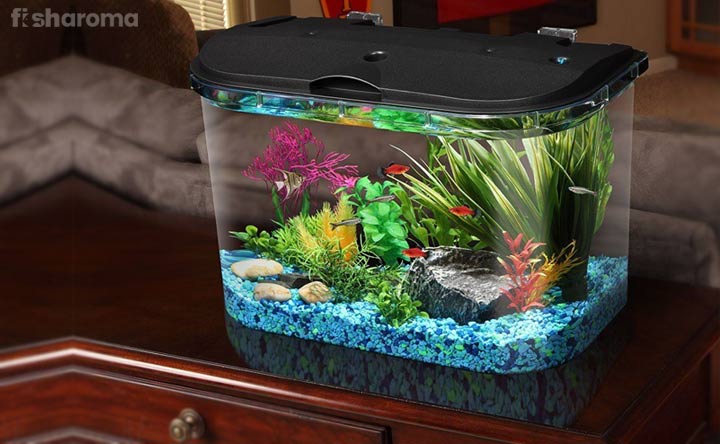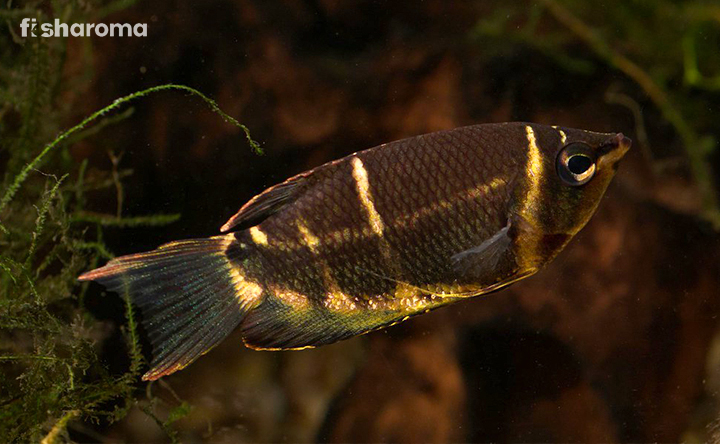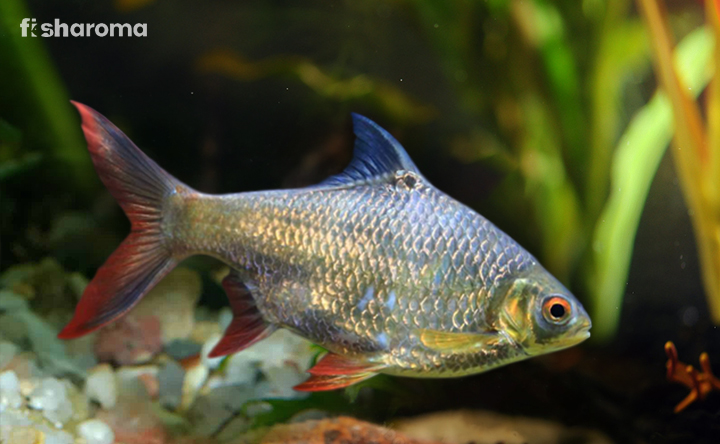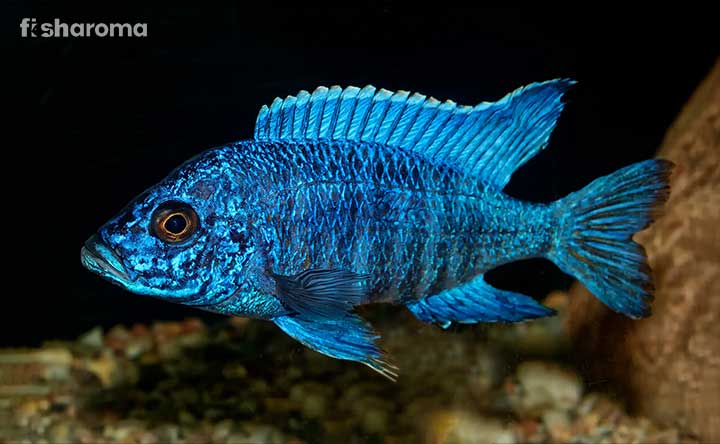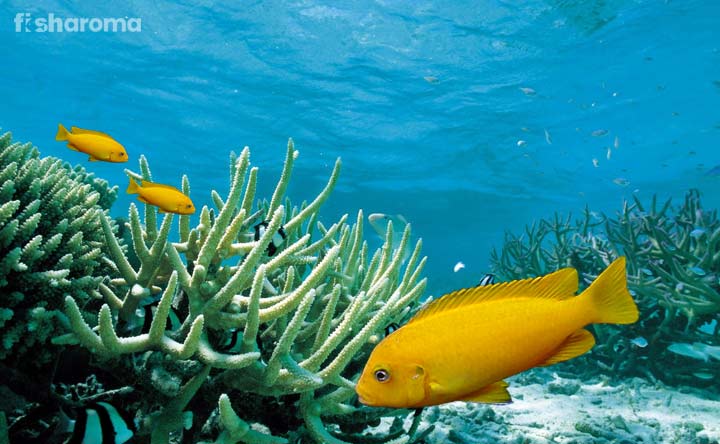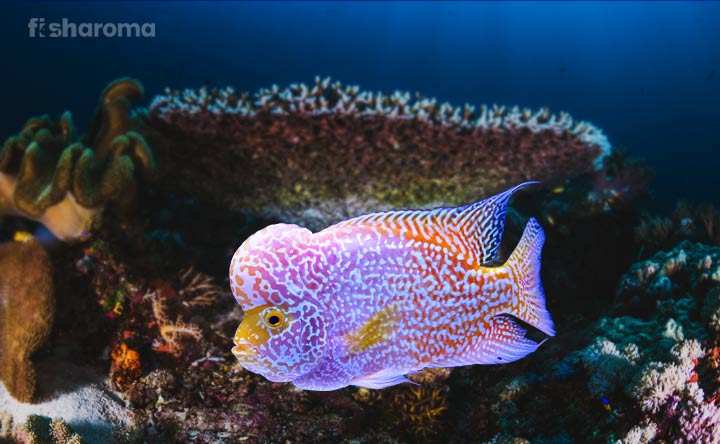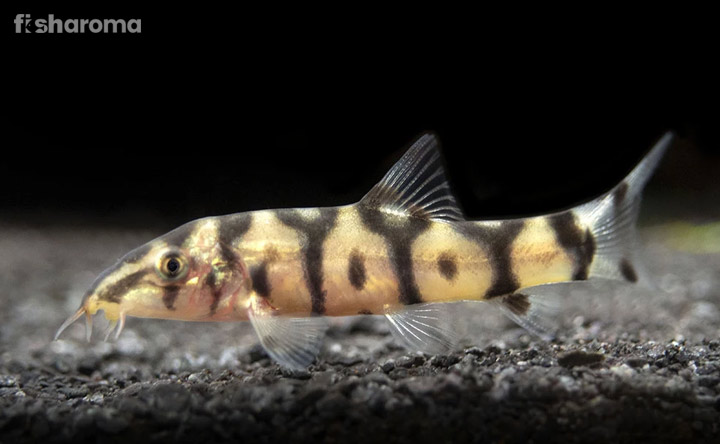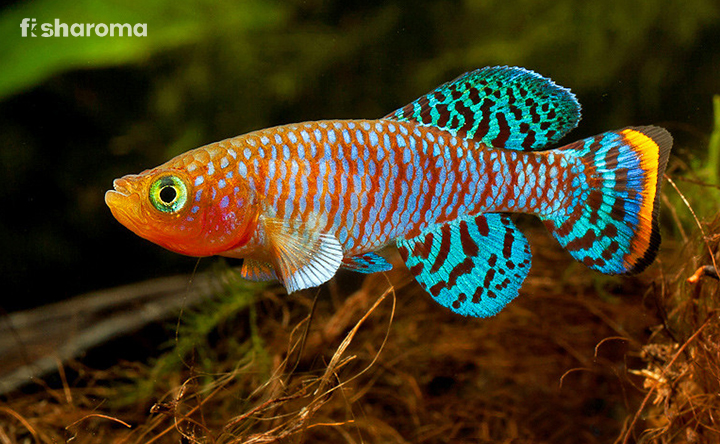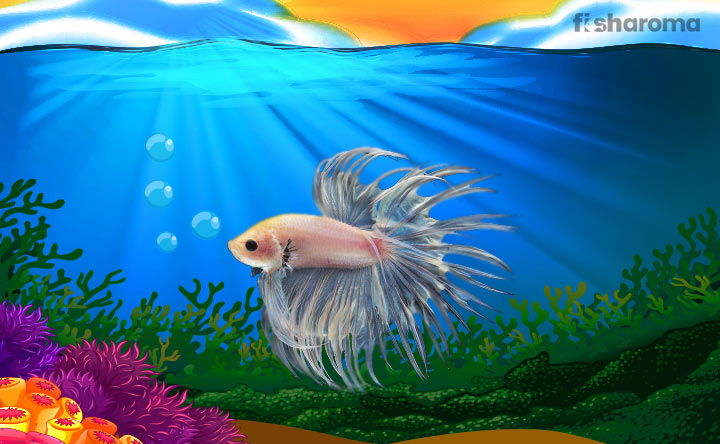Jack Dempsey Fish – The Complete Care Guide of this tropical freshwater fish
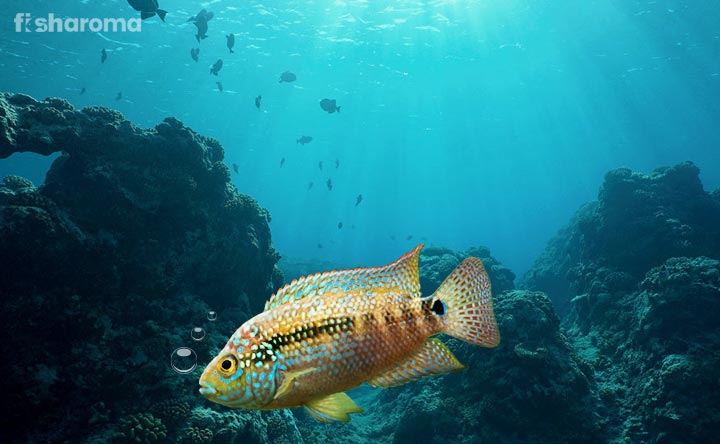
- Origin & Habitat of Jack Dempsey Fish
- Appearance of Jack Dempsey Fish
- Behavior of Jack Dempsey Fish
- Lifestyle of Jack Dempsey Fish
- Diet of Jack Dempsey Fish
- Tank Requirements for Jack Dempsey Fish
- Water Type for Jack Dempsey Fish
- Compatibility of Jack Dempsey Fish
- Breeding of Jack Dempsey Fish
- Jack Dempsey Fish Diseases
- Summary
If you are one of those who love hosting a Cichlid in their tank, we are sure the Jack Dempsey fish has certainly grabbed your attention one time or another. One of the most well-known members of their family, the feisty personalities of these freshwater beauties have made them the subject of intrigue for many aquarium enthusiasts. But what does their care guide essentially involve? How can you healthily pet them at your home? We answer everything and more here.
Key Specifications of Jack Dempsey Fish
A brush through of the following details will give you an overall idea about this tropical freshwater fish.
| Scientific Name | Rocio octofasciata |
| Family | Cichlidae |
| Origin | North and Central America |
| Size | 10-15” (25-38 cm) |
| Color | Primarily gray with multi bright flecks |
| Care Level | Intermediate |
| Lifespan | 8-10 Years |
| Temperament | Aggressive |
| Compatibility | Low |
| Tank Size | 80-Gallons |
| Diet | Carnivore |
Overview
Belonging to the Cichlidae (Cichlid) family, Jack Dempsey fish or Rocio octofasciata as they are scientifically called, is a highly sought-after aquatic pet, primarily because of its magnificent appearance.
Taking a deep look into their nomenclature, two interesting stories come up. Their common name Jack Dempsey has been adopted after the legendary 1920s American professional boxer Jack Dempsey, known for his fierce persona and aggressive nature. So, you can figure out why this fish has been named so.
Coming to the first part of their scientific name, Rocio, which is their genus name, was picked as a tribute to the wife of its describing author, Regan. In addition, the Spanish interpretation of this term is ‘morning dew’, which refers to the sparkling scales of this fish. The second part of their scientific name, which is the specific name octofasciata, has been derived from a combination of two Latin terms – ‘Octo’ meaning eight and ‘Fascia’ meaning stripes – which translates to ‘eight-striped’.
Origin & Habitat of Jack Dempsey Fish
Native to North and Central America, they can be found in abundance in Guatemala, Belize, Southern Mexico, Honduras, and Yucatan along the Atlantic coastal region. They mostly inhabit slow streams, bog with shallow water and swampy warm waters.
This tropical freshwater species can also be seen in murky rivers, lakes, and canals. Their habitat is also highly vegetative and has a muddy or sandy substrate with plenty of rocks. All these contribute to an area that has less access to light.
Appearance of Jack Dempsey Fish
Having an oval disk-shaped body, the Jack Dempsey fish sports pointed dorsal and anal fins. The fins are more elaborate and long in males than females.
There are prominent stripes on their body, especially in case of juveniles, who contrary to popular belief have more than eight stripes. Sometimes, the number goes up to ten or eleven. In adults, the stripes are restricted to their abdomen, forehead, and back.
The compact proportion of their body gives them the spectacular look that we are fond of.
Size of Jack Dempsey Fish
One of the largest Cichlids in the wild, the Jack Dempsey fish can grow up to 8-10” (20-25 cm).
Color of Jack Dempsey Fish
There are many varieties of Jack Dempsey, all of whom display distinct colors, ranging from pink to gold to even blue. Colors vary from individual to individual and the colors develop prominently as they age, changing from pale in their young days to dark in their adulthood.
In most cases, however, this species has a dark-gray body with contrasting iridescent flecks in gold, green, and blue. There is a black spot at the center of their body and at the base of their tail. Their fins are also marked by a red band.
In case of females, there is a dark spot on their dorsal fin and an additional spot on the bottom edge of their gill cover. They also have fewer color flecks in their body when compared to their male counterparts.
Young Jack Dempseys have a tan or light background with subtle turquoise flecks. When exposed to a high-stress environment, the color on their body fades away and so does the spots.
It takes around a year since birth for the full colorations and for patterns to develop in a Jack Dempsey fish.
Behavior of Jack Dempsey Fish
Jack Dempseys are territorial in nature and they are known for displaying aggressive behavior. This is the reason why we don’t recommend it for beginner aquarists.
It has been noted that their aggression is much lower in highly populated tanks since that disrupts with their idea of picking on a single fish. Providing a lot of hiding spaces also helps keep them calm as it gives them the much-needed space they need. In fact in the wild, it burrows its own hiding place on the substrate.
Lifespan of Jack Dempsey Fish
You are in luck if you prefer long-living species in your aquarium since, on an average, Jack Dempseys live up to 8-10 years. In fact, maintaining it healthily will allow it to live for even 15 years.
Diet of Jack Dempsey Fish
Carnivores by nature, their diet is pretty diverse when it comes to meaty foods. Although live foods are recommended for maintaining their health, we understand that it is not always easy to have access to such food. Therefore, feel free to feed them pellets and flakes that are exclusively designed for Cichlids.
They tend to nip live plants. Although they are not heavily dependent on vegetarian food, providing them blanched cucumber and lettuce from time to time will help save your aquatic plant from being nipped away.
A proper diet of a Jack Dempsey should consist of the following.
- Bloodworms
- Brine Shrimp
- Grasshoppers
- Crickets
- Daphnia
- Blackwomrs
- Fruit Flies
- Blanched Cucumber
- Lettuce
- Crustaceans
- Insects
- Non-acidic fruit
Feed them the type of food that can fit into their mouth. Feeding them for two minutes twice a day is ideal. However, in case of the young ones, you need to feed them thrice to help them grow. Having said that, do not overfeed them.
Do not feed a Jack Dempsey any type of warm-blooded meat such as poultry or beef since the kind of fats and proteins present in these meats are harmful to their health, especially if they are fed in large quantity.
Tank Requirements for Jack Dempsey Fish
In order to ensure the living environment of your tank matches with the natural habitat of a Jack Dempsey, you need to keep the following things in mind.
Tank Size
Owing to their territorial nature, you have to provide them a large enough tank if you want to make sure that their stress level is low. For a single fish, you would require 55 gallons of water. So, that would give you an idea of the amount of space you need for hosting multiple Jack Dempseys.
Filter
Jack Dempseys live in slow-moving water. Therefore, get a filter that creates a low current in your tank. However, over-filtration with activated carbon can lead to various health hazards in them.
Nature of Lighting
In the wild, their habitat is mainly dark due to most of the sunlight getting diffused from the thick vegetation present. Thus, keep moderate to dim light in their tank.
Presence of Flora
As we just stated above, their habitat is filled with vegetation. These plants not only provide them shelter but also serve as hiding spots for them. So, don’t forget to add a dash of green to their aquarium.
However, make sure whatever aquatic plant you are keeping, they have hardy leaves because otherwise they can be easily nipped by this fish. Floating plants such as Hornworts are great for this fish.
Substrate
Go for a sandy or muddy substrate for this tropical creature. Make sure the substrate is soft in texture since Jack Dempseys dig holes in the substrate during breeding.
Ornaments
Since they spend a considerable amount of their time hiding, having a bunch of rocks and a cave would be a great addition for your tank. You just need to ensure that they don’t have any sharp edges on them since that would lead to injury.
Cleaning Method
Regular cleaning of the tank ensures that the health of the fish is maintained. Do not use any soap-based product to clean the tank; just lukewarm water would suffice. Also, in order to wipe the walls of the tank, simply use a soft cloth. We recommend you to clean the tank at least once a month.
Water Type for Jack Dempsey Fish
Since they are a freshwater species, tap water can be used as long as it does not have a high quantity of chemical in it. The water for a Jack Dempsey tank should have the following features.
Temperature
They prefer slightly warmer water. So, make sure the temperature of the tank stays 75-80° F (24-27° C).
pH Level
Moderately acidic water is ideal for this tropical freshwater species. So, keep the pH level of water 6-7.
Hardness
The general hardness of the water should be 9-20 dGH.
Replacement Procedure
Water replacement is an essential component for increasing the longevity of your pet fish. The golden rule of water replacement is to never change the entire water altogether since that would eliminate the beneficial bacteria from the tank. In addition, it would also send a shock to them.
For changing the water content, you can choose any of the three following procedures.
- Replace 10% of the tank water on a weekly basis or;
- Replace 20% of the tank water every two weeks or;
- Replace 40% of the tank water on a monthly basis.
Compatibility of Jack Dempsey Fish
Given their aggressive nature, it is pretty obvious and understandable that they are compatible with very few species, including their own. When keeping more than one Jack Dempsey together, not only do you need a large space together, but you also have to make sure that there is only one male in a tank, else there will be violent exchanges between them.
Suitable Tankmates for Jack Dempsey Fish
When looking for a tankmate for a Jack Dempsey fish, you have to look for a small, semi-aggressive fish that can defend itself. Keeping this in mind, the suitable tankmates for a Jack Dempsey are as follows.
- Angelfish
- Firemouth Cichlid
- Silver Dollar
- Convict Cichlid
- Clown Loaches
- Blue Acara
- Mbuna Cichlid
- Oscar
Unsuitable Tankmates for Jack Dempsey Fish
Peaceful fish will be harassed and quite possibly, be killed. So, they need to be avoided too. No fish that can fit in their mouth should be kept with them.
Small fish and invertebrates should not be kept with them since they would be viewed as food. So, avoid keeping species like Tetra or any kind of shrimps or snails with them.
Breeding of Jack Dempsey Fish
Jack Dempseys are pretty easy to breed since they do not have heavy requirements for spawning. However, they do become more aggressive and territorial during the process, even resorting to biting.
Their color darkens when they are ready to mate. It has been noted that the males will harass the females to death if the latter refuses to mate with them.
The temperature of the water should be 84° F (28° C). These fish are known to produce up to 500 eggs after mating. The substrate, aquarium décor, or even the walls serve as the platform for these eggs to rest. They usually hatch after a period of three days.
Extremely protective of their young fries, a Jack Dempsey often digs holes in the substrate to shelter them in order to keep them away from being eaten. Both the mother and father contribute equally to protecting them. They even crush up their food for them.
However, in a poor or stressful environment, they are known to eat their young ones. So, keep a watch on them and make sure they are not disturbed and that they have everything they need with them during this breeding process.
Jack Dempsey Fish Diseases
Similar to other freshwater species, Jack Dempseys are also vulnerable to various diseases, especially the parasitic ones like Ich. Also known as the White Spot disease, they are marked by white nodules on their bodies and fins. Poor water condition is the primary reason behind this disease.
To cure this, increase the temperature of the water to 86° F (30° C). At this optimal temperature, the parasites responsible for this disease are killed. Don’t forget to bring the temperature back to normal once they have been treated from the disease.
Another common disease found in them is the Head and Lateral Line Erosion (HLLE). Its symptoms include pits or cavities on the face and head of the fish. A lack of proper nutrients such as Vitamin C, Vitamin D, phosphorus, or calcium is the primary cause behind this disease. Over-filtration with carbon, poor water condition or lack of diet can also lead to this disease.
Skin flukes and other parasitic infestations by worms and protozoa are also major concerns in them. Besides, there are also other bacterial and fungal infections that can put the health of your fish in jeopardy. Quarantining your new fish and also any new items you buy is extremely important to help avoid most diseases.
Regular replacement of water along with regular cleaning of your tank will work wonders towards contributing to the healthy life of your fish. Also, use chemicals in recommended quantities or on expert advice.
Interesting Facts about Jack Dempsey Fish
- This fish was previously known as Heros, Cichlasoma, and Archocentrus.
- In recent times, they have become an invasive species in Russia, the United States, and Thailand.
- The bright blue Jack Dempsey is believed to be a result of genetic mutation observed among tank fish.
- Jack Dempseys are known for forming nuclear families.
Summary
Jack Dempseys are one of the most fascinating freshwater creatures that you can host in your tank. With an eclectic look and fierce demeanor, they bring a sort of dynamism to your tank, unlike any other fish. Although they are easy to breed and feed, choosing tankmates for them is tricky due to their aggressive and hostile behavior. A pretty non-demanding fish otherwise, they are not recommended for beginners based on the said reasons. But once you have mastered the art of petting them, they will become the next greatest addition to your tank. We hope our care guide will keep you well-prepared to host them healthily in your tank.
Guide to Other Freshwater Fish
Take a sneak peek into the care guides of other freshwater fish.
- Black Ghost Knifefish – Sporting an unconventional look, they surely would grab the attention of your visitors if you are able to healthily keep them in your tank.
- Harlequin Rasbora – Easy to host, these peaceful red angels are an excellent choice if you are looking for schooling fish.
- Siamese Fighting Fish – Owner of the most beautiful fins in the world, these fierce beasts are one of the most popular aquarium pets in the world.

